12.SpringSecurity-实现图形验证码
前言
实现图形验证码:
- 开发生成图形验证码接口
- 在认证流程中加入图形验证码校验
- 重构代码
内容
1.开发生成图形验证码接口
根据随机数生成图片
将随机数存到session中
将生成图片写到接口的响应中
1.1 验证码对象封装
放到公用模块core中,用于app,web端公用。
public class ImageCode {
private BufferedImage image;
/**
* code是一个随机数,图片是根据随机数生成的,
* 存放到session里面,后面用户提交登录请求时候要去验证的
*/
private String code;
/**
* 过期时间
*/
private LocalDateTime expireTime;
public ImageCode(BufferedImage image,String code,int expireIn){
this.image=image;
this.code=code;
/**
* 过期时间传递的参数应该是一个秒数:根据这个秒数去计算过期时间
*/
this.expireTime = LocalDateTime.now().plusSeconds(expireIn);
}
public BufferedImage getImage() {
return image;
}
public void setImage(BufferedImage image) {
this.image = image;
}
public String getCode() {
return code;
}
public void setCode(String code) {
this.code = code;
}
public LocalDateTime getExpireTime() {
return expireTime;
}
public void setExpireTime(LocalDateTime expireTime) {
this.expireTime = expireTime;
}
}
1.2.验证码逻辑处理接口
@RestController
public class ValidateCodeController {
private static final String SESSION_KEY = "SESSION_KEY_IMAGE_CODE";
private SessionStrategy sessionStrategy = new HttpSessionSessionStrategy();
@GetMapping("/code/image")
public void createCode(HttpServletRequest request, HttpServletResponse response) throws IOException {
/**
* 1.根据随机数生成图片
* 2.将随机数存到session中
* 3.将生成图片写到接口的响应中
*/
ImageCode imageCode = createImageCode(request);
sessionStrategy.setAttribute(new ServletWebRequest(request),SESSION_KEY,imageCode);
ImageIO.write(imageCode.getImage(),"JPEG",response.getOutputStream());
}
private ImageCode createImageCode(HttpServletRequest request) {
int width = 67;
int height = 23;
BufferedImage image = new BufferedImage(width, height, BufferedImage.TYPE_INT_RGB);
Graphics g = image.getGraphics();
Random random = new Random();
g.setColor(getRandColor(200, 250));
g.fillRect(0, 0, width, height);
g.setFont(new Font("Times New Roman", Font.ITALIC, 20));
g.setColor(getRandColor(160, 200));
for (int i = 0; i < 155; i++) {
int x = random.nextInt(width);
int y = random.nextInt(height);
int xl = random.nextInt(12);
int yl = random.nextInt(12);
g.drawLine(x, y, x + xl, y + yl);
}
String sRand = "";
for (int i = 0; i < 4; i++) {
String rand = String.valueOf(random.nextInt(10));
sRand += rand;
g.setColor(new Color(20 + random.nextInt(110), 20 + random.nextInt(110), 20 + random.nextInt(110)));
g.drawString(rand, 13 * i + 6, 16);
}
g.dispose();
return new ImageCode(image, sRand, 60);
}
/**
* 生成随机背景条纹
*
* @param fc
* @param bc
* @return
*/
private Color getRandColor(int fc, int bc) {
Random random = new Random();
if (fc > 255) {
fc = 255;
}
if (bc > 255) {
bc = 255;
}
int r = fc + random.nextInt(bc - fc);
int g = fc + random.nextInt(bc - fc);
int b = fc + random.nextInt(bc - fc);
return new Color(r, g, b);
}
}
1.3.前端获取验证码
<!DOCTYPE html>
<html>
<head>
<meta charset="UTF-8">
<title>登录</title>
</head>
<body>
<h2>标准登录页面</h2>
<h3>表单登录</h3>
<form action="/authentication/form" method="post">
<table>
<tr>
<td>用户名:</td>
<td><input type="text" name="username"></td>
</tr>
<tr>
<td>密码:</td>
<td><input type="password" name="password"></td>
</tr>
<tr>
<td>图形验证码</td>
<td>
<input type="text" name="imageCode">
<img src="/code/image">
</td>
</tr>
<tr>
<td colspan="2"><button type="submit">登录</button></td>
</tr>
</table>
</form>
</body>
</html>
1.4 在授权模块添加:允许验证码生成请求permitAll()
@Configuration
public class WebSecurityConfig extends WebSecurityConfigurerAdapter {
@Autowired
private SecurityProperties securityProperties;
@Autowired
private MyAuthenticationSuccessHandler myAuthenticationSuccessHandler;
@Autowired
private MyAuthenticationFailureHandler myAuthenticationFailureHandler;
@Bean
public PasswordEncoder passwordEncoder(){
return new BCryptPasswordEncoder();
}
/**
* 定义web安全配置类:覆盖config方法
* 1.参数为HttpSecurity
*/
@Override
protected void configure(HttpSecurity http) throws Exception {
/**
* 定义了任何请求都需要表单认证
*/
http.formLogin()//表单登录---指定了身份认证方式
// .loginPage("/login.html")
.loginPage("/authentication/require")
.loginProcessingUrl("/authentication/form")//配置UsernamePasswordAuthenticationFilter需要拦截的请求
.successHandler(myAuthenticationSuccessHandler)//表单登录成功之后用自带的处理器
.failureHandler(myAuthenticationFailureHandler)//表单登录失败之后用自带的处理器
// http.httpBasic()//http的basic登录
.and()
.authorizeRequests()//对请求进行授权
.antMatchers("/authentication/require",securityProperties.getBrowser().getLoginPage(),"/code/image").permitAll()//对匹配login.html的请求允许访问
.anyRequest()//任何请求
.authenticated()
.and()
.csrf().disable();//都需要认证
}
}
2.在认证流程中加入图形验证码校验 过滤器

我们在实现登录请求时候 都是在实现Spring提供的接口;并且加密解密实现都是Spring已经提供给我们自己的,但是spring并没有给我们提供图形验证码,因为spring security他的基本原理就是一个过滤器链。在这个链上我们可以加入自己写的过滤器。我们在UsernamePasswordAuthticationFilter前加一个自定义的过滤器。 extends OncePerRequestFilter。实现:doFilterInternal方法。
public class ValidateCodeFilter extends OncePerRequestFilter {
@Autowired
private AuthenticationFailureHandler authenticationFailureHandler;
@Autowired
private SessionStrategy sessionStrategy;
private Logger logger = LoggerFactory.getLogger(getClass());
@Override
protected void doFilterInternal(HttpServletRequest request, HttpServletResponse response, FilterChain filterChain) throws ServletException, IOException {
logger.info("验证码过滤器:doFilterInternal: requestURI:[{}] requestMethod:[{}]",request.getRequestURI(),request.getMethod());
/**
* 如果是需要认证请求,我们进行家宴
* 如果校验失败,使用我们自定义的校验失败处理类处理
* 如果不需要认证,我们放行进入下一个Filter
*/
if(StringUtils.equals("/authentication/form",request.getRequestURI()) && StringUtils.endsWithIgnoreCase(request.getMethod(),"post")){
try{
validate(new ServletWebRequest(request));
}catch (ValidateCodeException e){
authenticationFailureHandler.onAuthenticationFailure(request,response,e);
}
}
filterChain.doFilter(request,response);
}
private void validate(ServletWebRequest servletWebRequest) throws ServletRequestBindingException {
//1.获取存放到session中的验证码
ImageCode codeInSession = (ImageCode)sessionStrategy.getAttribute(servletWebRequest, ValidateCodeController.SESSION_KEY);
//2.获取请求中的验证码
String codeInRequest = ServletRequestUtils.getStringParameter(servletWebRequest.getRequest(), "imageCode");
if(StringUtils.isBlank(codeInRequest)){
throw new ValidateCodeException("验证码的值不能为空");
}
if(codeInSession == null){
throw new ValidateCodeException("验证码不存在")
}
if(codeInSession.isExpried()){
sessionStrategy.removeAttribute(servletWebRequest,ValidateCodeController.SESSION_KEY);
throw new ValidateCodeException("验证码已过期");
}
if(StringUtils.equals(codeInSession.getCode(),codeInRequest)){
throw new ValidateCodeException("验证码不匹配")
}
sessionStrategy.removeAttribute(servletWebRequest,ValidateCodeController.SESSION_KEY);
}
}
需要把自定义的过滤器加到UsernamePasswordAuthenticationFilter前面去。
@Configuration
public class WebSecurityConfig extends WebSecurityConfigurerAdapter {
@Autowired
private SecurityProperties securityProperties;
@Autowired
private MyAuthenticationSuccessHandler myAuthenticationSuccessHandler;
@Autowired
private MyAuthenticationFailureHandler myAuthenticationFailureHandler;
@Bean
public PasswordEncoder passwordEncoder(){
return new BCryptPasswordEncoder();
}
/**
* 定义web安全配置类:覆盖config方法
* 1.参数为HttpSecurity
*/
@Override
protected void configure(HttpSecurity http) throws Exception {
/**
* 定义了任何请求都需要表单认证
*/
ValidateCodeFilter validateCodeFilter = new ValidateCodeFilter();
validateCodeFilter.setAuthenticationFailureHandler(myAuthenticationFailureHandler);
http.addFilterBefore(validateCodeFilter, UsernamePasswordAuthenticationFilter.class)
.formLogin()//表单登录---指定了身份认证方式
// .loginPage("/login.html")
.loginPage("/authentication/require")
.loginProcessingUrl("/authentication/form")//配置UsernamePasswordAuthenticationFilter需要拦截的请求
.successHandler(myAuthenticationSuccessHandler)//表单登录成功之后用自带的处理器
.failureHandler(myAuthenticationFailureHandler)//表单登录失败之后用自带的处理器
// http.httpBasic()//http的basic登录
.and()
.authorizeRequests()//对请求进行授权
.antMatchers("/authentication/require",securityProperties.getBrowser().getLoginPage(),"/code/image").permitAll()//对匹配login.html的请求允许访问
.anyRequest()//任何请求
.authenticated()
.and()
.csrf().disable();//都需要认证
}
}
我们重启服务,测试:
1.web端输入:( http://127.0.0.1 :8088/login.html)
输入用户名/密码;但是不输入验证码时候;
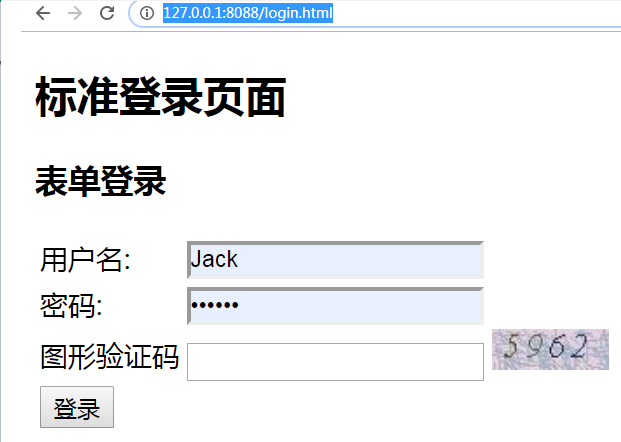
后台报了验证码异常:
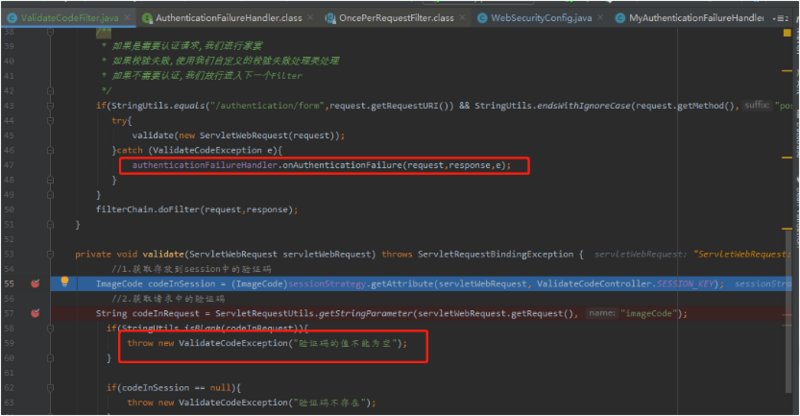
然后走了我们自己失败处理:由于项目配置的不是json格式:
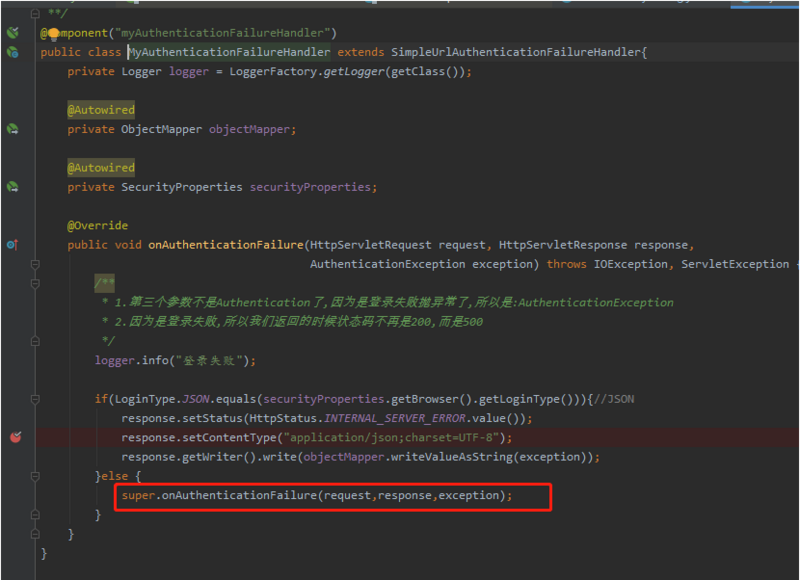
所以排除异常:跳转到SpringBoot提供的页面:
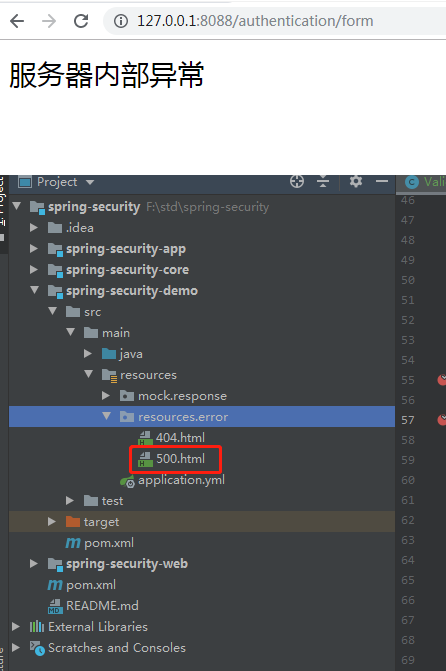
我们修改下demo的配置:
登录类型改为:JSON
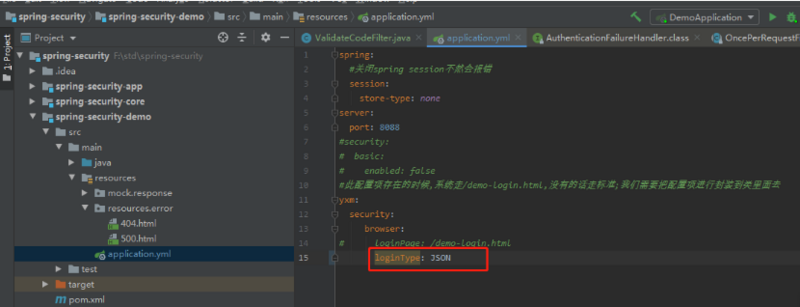
然后重启服务尝试登录:此时报出的异常为:

缺点:1.打印出了堆栈信息
2.将认证的信息:用户名/密码;说明我们调用到了后端的UsernamePasswordFilter过滤器了(按理我们应该不能调用到)
针对第一个问题:在自定义错误处理器中,我们返回给前端的返回异常消息即可。
@Component("myAuthenticationFailureHandler")
public class MyAuthenticationFailureHandler extends SimpleUrlAuthenticationFailureHandler{
private Logger logger = LoggerFactory.getLogger(getClass());
@Autowired
private ObjectMapper objectMapper;
@Autowired
private SecurityProperties securityProperties;
@Override
public void onAuthenticationFailure(HttpServletRequest request, HttpServletResponse response,
AuthenticationException exception) throws IOException, ServletException {
/**
* 1.第三个参数不是Authentication了,因为是登录失败抛异常了,所以是:AuthenticationException
* 2.因为是登录失败,所以我们返回的时候状态码不再是200,而是500
*/
logger.info("登录失败");
if(LoginType.JSON.equals(securityProperties.getBrowser().getLoginType())){//JSON
response.setStatus(HttpStatus.INTERNAL_SERVER_ERROR.value());
response.setContentType("application/json;charset=UTF-8");
//返回给前端错误信息时候,打印出异常消息即可。
response.getWriter().write(objectMapper.writeValueAsString(new SimpleResponse(exception.getMessage())));
}else {
super.onAuthenticationFailure(request,response,exception);
}
}
}

针对第二个问题:在ValidateCodeFilter校验失败后立马结束。
@Override
protected void doFilterInternal(HttpServletRequest request, HttpServletResponse response, FilterChain filterChain) throws ServletException, IOException {
logger.info("验证码过滤器:doFilterInternal: requestURI:[{}] requestMethod:[{}]",request.getRequestURI(),request.getMethod());
/**
* 如果是需要认证请求,我们进行家宴
* 如果校验失败,使用我们自定义的校验失败处理类处理
* 如果不需要认证,我们放行进入下一个Filter
*/
if(StringUtils.equals("/authentication/form",request.getRequestURI()) && StringUtils.endsWithIgnoreCase(request.getMethod(),"post")){
try{
validate(new ServletWebRequest(request));
}catch (ValidateCodeException e){
authenticationFailureHandler.onAuthenticationFailure(request,response,e);
//抛出异常校验失败,不再走小面过滤器执行链
return;
}
}
filterChain.doFilter(request,response);
}
正常正度得到如下结果:

3. 重构代码
重构图形验证码主要是下面3个方面:
- 验证码基本参数可配置
- 验证码拦截的接口可配置
- 验证码的生成逻辑可配置
3.1 验证码基本参数可配置:
- 验证码长宽可配置
- 验证码位数可配置
- 验证码有效时间可配置
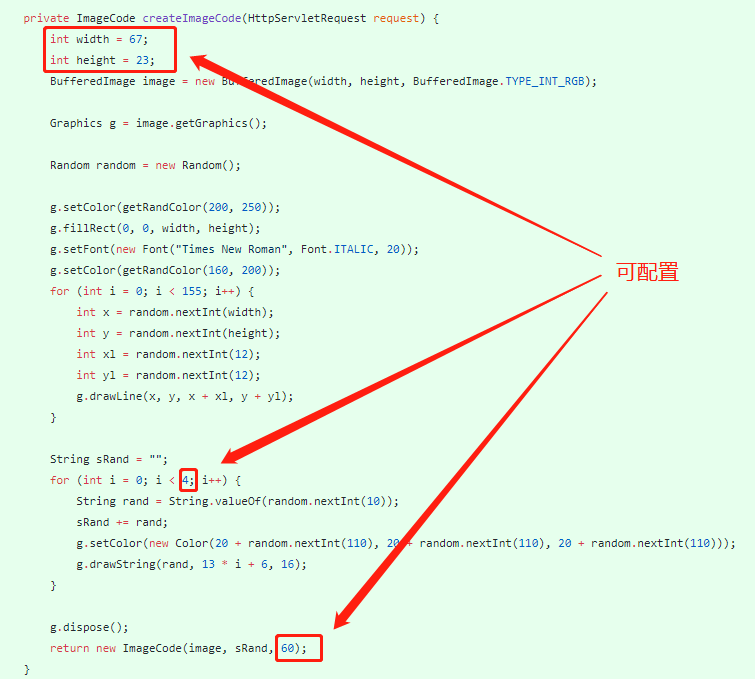
针对于基本参数配置,我们做成3级配置。
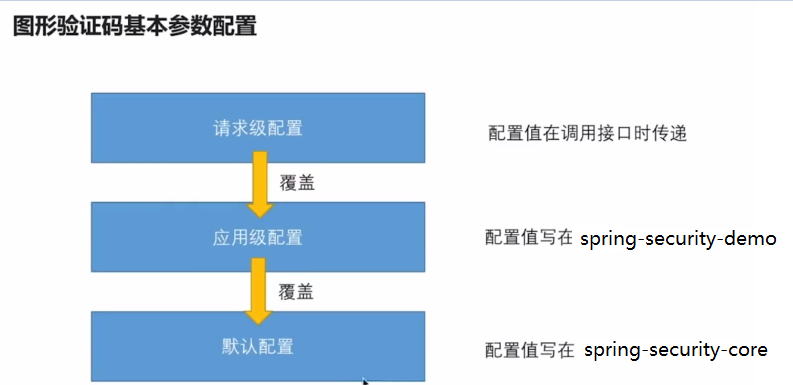
默认配置写在spring-security-core里面,
应用级别配置是自己应用的配置。
请求级配置:调用接口时传递参数配置,在各个请求时候图形验证码大小可能不一致的。
3.1.1 默认配置
将验证码长宽可配置、验证码位数可配置、验证码有效时间可配置作为属性参数写到配置中;
ImageCodeProperties:
public class ImageCodeProperties {
private int width = 67;
private int height = 23;
private int length = 4;
private int expireIn = 60;
//getter setter
}
我们后面还会讲解短信验证码,所以我们的配置做成多个类级别配置:ValidateCodeProperties;
public class ValidateCodeProperties {
private ImageCodeProperties image = new ImageCodeProperties();
public ImageCodeProperties getImage() {
return image;
}
public void setImage(ImageCodeProperties image) {
this.image = image;
}
}
最后封装到:
//此类读取配置文件里所有以yxm.security开头的配置
@ConfigurationProperties(prefix = "yxm.security")
public class SecurityProperties {
//其中yxm.security.browser开头的配置否会读取到BrowserProperties中
private BrowserProperties browser = new BrowserProperties();
private ValidateCodeProperties code = new ValidateCodeProperties();
//getter setter
}
3.1.2 应用级配置
我们在spring-security-demo应用下自己在配置文件里面配置:
yxm.security.code.image.length=6
3.1.3 请求级配置
请求级别配置就是在ValidateCodeController里面验证码的生成:从request前端获取不到值 就用默认配置,能获取到值就用前端传递过来的配置。
public ImageCode generate(ServletWebRequest request) {
//从request前端获取不到值 就用默认配置,能获取到值就用前端传递过来的配置
int width = ServletRequestUtils.getIntParameter(request.getRequest(),"width",securityProperties.getCode().getImage().getWidth());
int height = ServletRequestUtils.getIntParameter(request.getRequest(),"height",securityProperties.getCode().getImage().getHeight());
BufferedImage image = new BufferedImage(width, height, BufferedImage.TYPE_INT_RGB);
Graphics g = image.getGraphics();
Random random = new Random();
g.setColor(getRandColor(200, 250));
g.fillRect(0, 0, width, height);
g.setFont(new Font("Times New Roman", Font.ITALIC, 20));
g.setColor(getRandColor(160, 200));
for (int i = 0; i < 155; i++) {
int x = random.nextInt(width);
int y = random.nextInt(height);
int xl = random.nextInt(12);
int yl = random.nextInt(12);
g.drawLine(x, y, x + xl, y + yl);
}
String sRand = "";
for (int i = 0; i < securityProperties.getCode().getImage().getLength(); i++) {
String rand = String.valueOf(random.nextInt(10));
sRand += rand;
g.setColor(new Color(20 + random.nextInt(110), 20 + random.nextInt(110), 20 + random.nextInt(110)));
g.drawString(rand, 13 * i + 6, 16);
}
g.dispose();
return new ImageCode(image, sRand, securityProperties.getCode().getImage().getExpireIn());
}
我们将页面请求参数设置为:200,应用demo配置中改为100;
<tr>
<td>图形验证码</td>
<td>
<input type="text" name="imageCode">
<img src="/code/image?width=200">
</td>
</tr>
yxm.security.code.image.width=100
我们启动应用,发现:我们请求的url中width=200的值会覆盖掉:spring-security-demo里面的width=100的值;spring-security-demo里面的length=6的值覆盖掉系统默认的4。
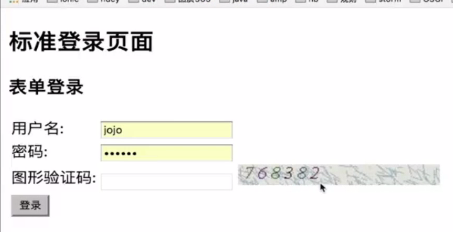
3.2 验证码拦截接口可配置
目前我们验证码过滤器拦截的接口是写死的: /authentication/form
但是我们这个校验的逻辑是可以运用在多个应用上的。比如我们的用户访问接口:"/user"也需要验证码校验的,那么这个时候,我们可以把其配置到验证码拦截接口url上去。应用使用验证码时候可以指定哪些服务需要校验验证码。
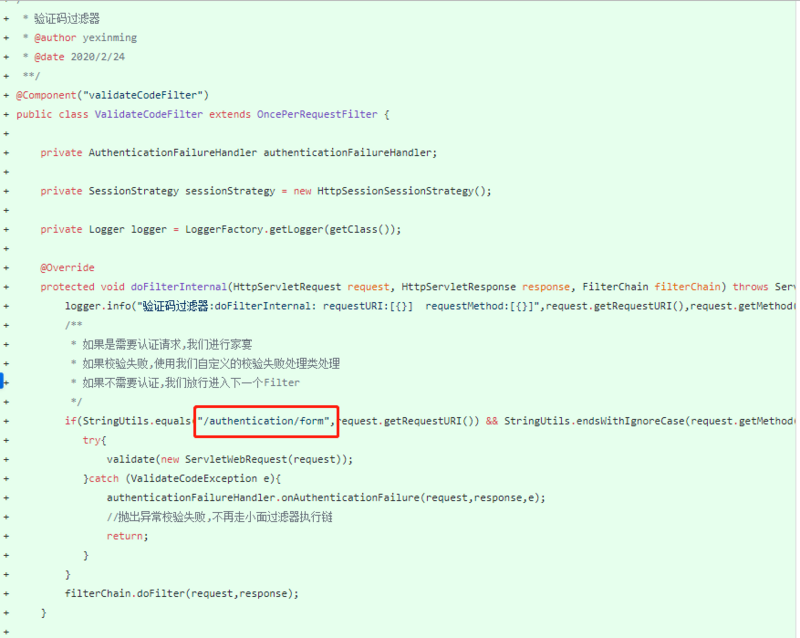
我们在ImageCodeProperties里面添加:url

3.3 验证码生成逻辑可配置
我们现在图形验证码逻辑是写死的,是一个相对简单的逻辑,有些项目可能需要更复杂的验证码,我们通过配置来替换这一段验证码。
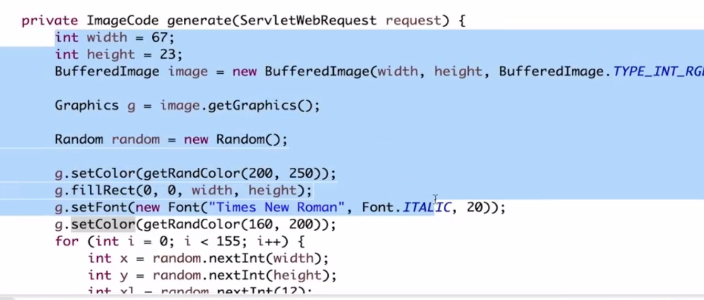
- 本文标签: 测试 Security 安全 id HTML src ORM IDE equals value web message cat MQ App final tab bean UI session key ssh Word js IO rand CTO 开发 authenticate Action 配置 springboot json spring http https 图片 加密 时间 参数 认证 处理器 map Spring Security DOM rmi core servlet mapper 代码 stream REST
- 版权声明: 本文为互联网转载文章,出处已在文章中说明(部分除外)。如果侵权,请联系本站长删除,谢谢。
- 本文海报: 生成海报一 生成海报二











![[HBLOG]公众号](https://www.liuhaihua.cn/img/qrcode_gzh.jpg)

